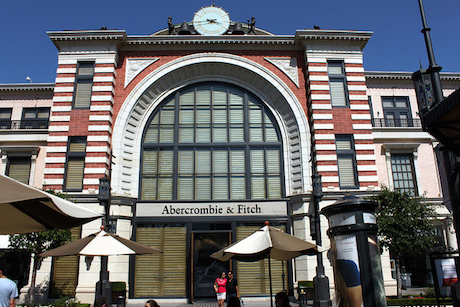One of the most extreme, eye-catching, and polarizing names in in-store branding is going through a complete transformation. Abercrombie & Fitch has long been known for its shuttered stores, loud pop music, and pungent distinctive fragrance. This unique in-store experience gave the clothing brand an exclusive and edgy feel that made it popular with an affluent young crowd. Through the early 2000’s the company boomed and stores adorned with images of shirtless youths could be found in malls across the country. However, Abercrombie has fallen on hard times. With H&M and Forever 21 offering low-priced clothing items mimicking high-end fashion in brightly lit stores, the classically preppy polo shirt style has fallen out of favor with high-school aged Americans. Abercrombie has also faced self-inflicted complications, including controversial comments by the CEO Mike Jeffries and internal strife between activist investors and company leaders. Without significantly changing the core brand offerings, A&F has closed 170 retail stores since 2009 and suffered a 77% drop in profits last year.
Abercrombie and Fitch has decided to make a big change. Though the changes to the product line will be relatively small (black is no longer strictly forbidden from the line) the in-store brand is going under a major overhaul. Shades are removed from windows, fragrances are drastically reduced, and music volume will be decreased from late-night dance club to trendy bar decibel levels. This is a change to move the store from exclusive and overwhelming to welcoming and modern. The impact of these changes are still unknown and will be followed closely by store designers. Abercrombie has one of the most recognizable store brands in the world and this shift by one of the pillars of mall store design will be tracked to see if this trend should be followed by major competition. For retailers currently pushing an edgy, polarizing shopping experience, A&F provides a case study in moving toward the center. Time will tell if toning down what makes a retailer unique, and perhaps dated, is the right move. Abercrombie is taking this new image increasingly international with expansion into Asia and the Middle East, so the brand will need to be palatable to both modern American youth and an increasingly affluent foreign market.
Many other retailers have gone through very successful rebrands in different ways. JCrew rebranded with an upscale and understated feel with a presidential endorsement (the Michelle Obama famously wore the brand on “The Tonight Show”). Burberry aligned themselves with an upscale and modern preppy look to move away from the Cadillac crowd. Neither of these rebrands were move towards the center, instead they featured loud endorsements from Hollywood and political elite. This blog will be watching this develop to see if Abercrombie can get a big win by scaling down their brand, instead of creating a new image.
